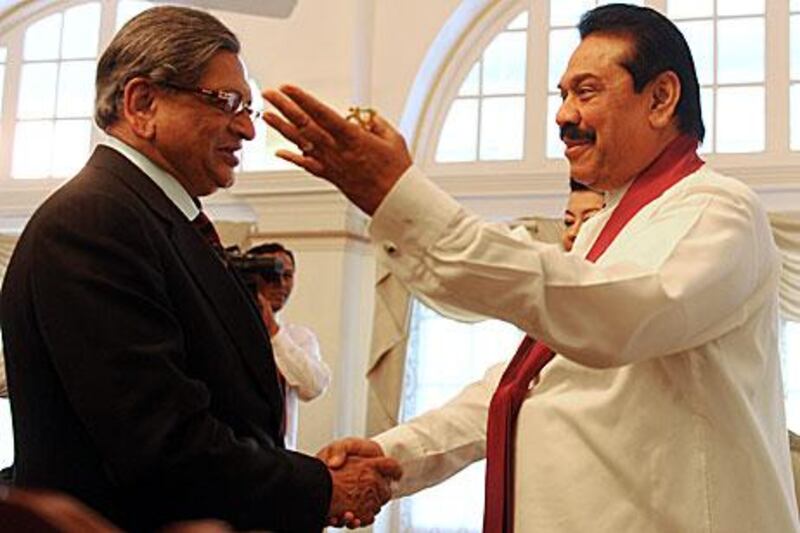CHENNAI, INDIA // With the dream of Tamil nationalism all but crushed, the Indian government finds increased freedom to compete against China's growing influence in Sri Lanka.
For years, India was torn between its desire to engage with Sri Lanka and the need to appease strong Tamil sentiment among its own citizens in the state of Tamil Nadu.
Last week's visit by the External Affairs Minister S M Krishna to Sri Lanka was an attempt to tread this fine line - combining talks with President Mahinda Rajapakse on increased economic cooperation with a trip to the war-ravaged areas in the north, where he assured the Tamil population of India's continued support.
A 30-year war waged by the Liberation Tigers of Tamil Eelam (LTTE) against the majority Sinhalese population came to a brutal end in May 2009 when the military crushed the last of the insurgent forces and killed its leader, Velupillai Prabhakaran.
Mr Krishna was the first Indian minister since the end of the war to visit Killinochi, once the headquarters of the Tamil Tigers, where he called for a "meaningful devolution package" that "would create the necessary conditions for a lasting political settlement."
The Tamils want increased control over their affairs and an end to government policies that favour the Sinhalese, who are the majority population on the island.
While the war raged, the Indian government was reluctant to do anything that might be construed as support for Mr Rajapakse's ruthless counterinsurgency. So, India turned down offers from the Sri Lankan government to sell it arms and invest in major economic projects.
That left the door open to China, which snapped up investment opportunities, exemplified by the US$1.5 billion (Dh5.5bn) port it helped to build at Hambantota on the southern tip of the island.
In interviews last year, Mr Rajapakse said the Hambantota project was only given to the Chinese after India failed to take them up on the offer.
The Indian foreign ministry denies claims that its famously sluggish bureaucracy was responsible for India missing out on the opportunity, which gave China a vital foothold along one of the busiest shipping lanes in the world.
"The technical requirements were such that Indian companies did not consider the project feasible," said a foreign ministry spokesman, and added that the port would still benefit India, which accounts for two-thirds of Sri Lanka's trade.
India has preferred smaller projects. During his visit to the war-ravaged district of Jaffna last week, Mr Krishna cut the ribbon on India-built housing projects and schools, handed out bicycles and announced plans to renovate a stadium, cultural centre and industrial zone.
Its investments are not focused purely on the Tamil regions. India is paying for a new railway line from Galle to Induruwa in the south, and announced 2.5 billion rupees (Dh183 million) in educational scholarships for all Sri Lankans.
Across the short stretch of water that divides Sri Lanka from Tamil Nadu, these limited initiatives are seen as a betrayal.
"It is a great injustice to the Tamil people," said Nanjil Sanbath, spokesman for the MDMK, a vehemently pro-Tamil party based in Chennai. "The Indian government and the rest of the world are lining up to support Rajapakse, while the Tamils are made to suffer like animals."
After the war, more than 300,000 Tamils were herded into internment camps while the government tried to identify former rebel fighters. Most have now been released, and the government said this weekend that only 550 people remain in detention.
Tamil activists are still seeking Mr Rajapakse's prosecution for war crimes. More than 7,000 people are thought to have died in the final months of the conflict in 2009.
But while the battle for accountability continues, hopes for a separate Tamil homeland are dim.
"The situation is very gloomy," said Father Gaspar Raj, a Catholic priest whose radio station in the Philippines became the voice of Tamil nationalism in the 1980s and 1990s. "There is no hope of the rebellion restarting. The military capability of the LTTE to wage another war has been crushed."
Rumours still abound in Tamil Nadu that Prabhakaran, who had built an almost mythical aura around himself, is still alive somewhere, hiding out and waiting for the right moment to restart his campaign.
"The radical elements of the movement had crystallised in one man," said K Venkataraman, the deputy editor at The Hindu newspaper in Chennai, who closely documented the insurgency for many years.
"Tamil nationalism became synonymous with Prabhakaran to the extent that when he died, the movement died."
But the staunchest supporters of the Tamils still see hope for the movement, which remains strong among the Tamil diaspora in Australia, Europe and North America.
"People see May 2009 as the end of Tamil nationalism," said Father Gaspar. "I see it as a rebirth. There was always too much militarism in the LTTE. Now we will fight without violence. The sense of defeat and loss will give a new impetus for Tamil identity to blossom."
[ foreign.desk@thenational.ae ]
Follow
The National
on
[ @TheNationalUAE ]
& Eric Randolph on
[ @EricWRandolph ]





